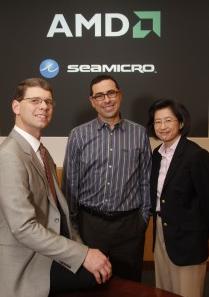
AMD has called a press conference in San Francisco on Monday where it’s likely to announce plans for a SeaMicro server based on an upcoming 64-bit processor design from ARM.
AMD CEO Rory Read is expected at the event, and an ARM spokesman confirmed Thursday that ARM CEO Warren East will be there as a “special guest.” AMD is also arranging press briefings at the event with Andrew Feldman, who was CEO of SeaMicro before AMD bought the company this year.
Those factors combined suggest that AMD will announce plans to offer a SeaMicro server based on an ARM processor. ARM’s chip designs are known for their low power consumption, and energy efficiency is a hallmark of the SeaMicro systems.
Spokespeople for AMD and ARM declined to comment.
Feldman has long held that the SeaMicro server platform can work with any type of CPU, and he was a speaker at ARM’s technology conference last year, when Applied Micro announced plans to build an ARM server platform.
“Feldman has been vocal about his technology fitting with ARM for a long time,” said Insight64 analyst Nathan Brookwood.
AMD’s press invitation says Monday’s event is to discuss its “ambidextrous strategy,” a plan it outlined in February to use other companies’ technologies in its products.
SeaMicro made its name by developing technologies that allow it to build highly dense, power-efficient servers for Internet-scale workloads. The technologies include a network fabric that can link thousands of servers at low latency, and a custom chip that replaces most of the components on a standard server board.
SeaMicro’s first products were based on Intel’s Atom and Xeon processors, and SeaMicro was a close partner of Intel before being bought by AMD for US$334 million. Last month it said it would also offer a server based on an AMD Opteron processor.
But SeaMicro’s roots are in low-power designs, so it would make sense for AMD to offer a server based on an ARM chip. Such chips are used in smartphones and tablets because of their low power characteristics.
AMD partnered with ARM earlier this year to use its TrustZone security technology in AMD processors, but it hasn’t announced any plans yet to build an ARM-based CPU. That could be about to change, however.
ARM offers two types of licenses for its CPUs. Companies can take an architectural license, which allows them to design a processor from scratch based on the ARM architecture. Alternatively, they can license a processor design that ARM has already created and then enhance it with some of their own technology.
It’s a “poorly kept secret” that ARM will announce its first 64-bit processor designs at its TechCon conference next week, Brookwood said. So AMD may well announce that it will license the design for use in SeaMicro servers.
AMD could build a system-on-chip that combines the ARM CPU with SeaMicro’s custom chip. Melding the parts together on one chip would help reduce costs and enable even higher-density server designs.
That work would take time, however. If AMD were to make a 64-bit processor design available later this year, it would take a chip maker at least 12 to 18 months to turn that into a finished product, Brookwood said.
By that estimate, an ARM-based SeaMicro server would be in the market in 2014.
It probably wouldn’t be the only company with such a product. Hewlett-Packard and Dell are just two of the vendors that are also pursuing ARM-based servers, as the industry looks to reduce power consumption in data centres.





